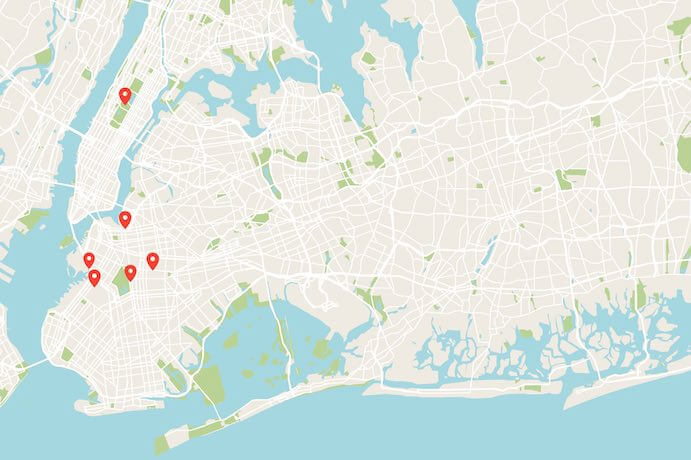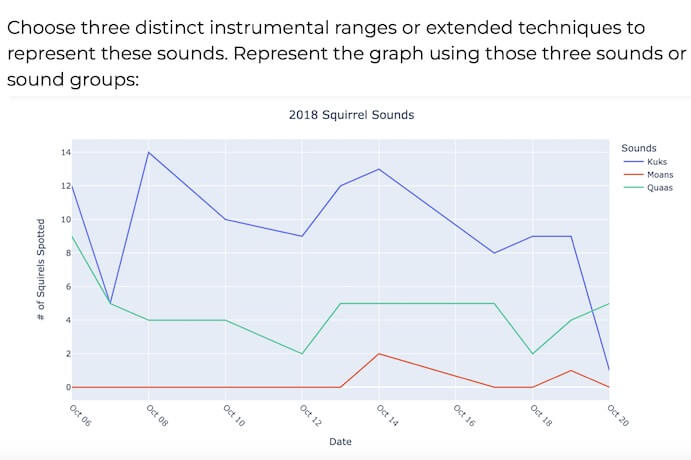Every single day as we move through the world, we use our senses to identify places and navigate among them. Some days we may travel to many places, and some days we may stay cooped up inside a single place. No matter where we go or what we do, our conceptions of place help us make sense of it all. Yet as we go about our routines, we often forget how subjective and fluid our understanding of place is. How might our ideas of place change when new data enters the picture? And what might that sound like?
These questions and more are considered in Counterpoints, a work by Mansi Shah (flute), Lucy Hatem (clarinet), and Torstein Johansen (bass) that explores boundaries between data and reality, observation, and experience. Counterpoints was premiered in March 2022 at The Hall in Brooklyn for Data Through Design’s NYC Open Data Week exhibition and can also be experienced in full on Shah’s website.
The landing page for Counterpoints features a statement about the work and instructions on how to best experience it. The piece begins with a map of New York that is annotated with half a dozen clickable pins, mostly in Brooklyn. As a modular, non-linear work, you are free to experience part or all of Counterpoints in any order.

I started my tour of Counterpoints by clicking on the Central Park location, which took me to two videos, a score, and some general information about the park. Central Park is the most visited urban park in the United States, and one in which I have personally spent hundreds of hours exploring and using. And yet this piece surprised me with its choice of subject: data from the Central Park Squirrel Census (CPSC) of 2018 is used to weave a story about the park and its furry inhabitants.
The piece pairs satellite images of Central Park from 2018–2022 with a group improvisation recorded by Shah, Hatem, and Johansen. The score (also linked on this page) features data related to squirrel sounds (“kuks, quaas, and moans”) collected by volunteers in over 700 sessions over 350 park hectares. Alongside this are “squirrel stories,” which are charming and quirky fragments of qualitative data collected by volunteers during the census: “Hectare was peacefully bustling. It was a peaceful bustle. A monk came to bless the squirrels.” Performers are instructed to choose distinct instrumental ranges or extended techniques to illustrate the graph of squirrel sounds, and to illustrate at least three squirrel stories in performance.
In experiencing a work like Counterpoints, it is impossible to separate the music from the work as a whole. While listening to the improvisations and perusing the score and text, the essence of the park’s squirrel population comes alive. I paused to meditate on certain squirrel stories while listening, and in turn, the music informed my experience of the text. The work relies upon multimedia elements to communicate its story and does so effectively.

The Gowanus Canal, with its contaminated and inhospitable water, is the subject of another piece. A chart of water quality and nutrient data collected from 2018–2021 features prominently in the score. Both the beauty and horrors of the water are mentioned in the accompanying text, alongside a question about the canal’s future: “What physical, chemical, and spiritual rebalancing is necessary for the restoration of this water body and the surrounding communities?” In the improvisation, Shah, Hatem, and Johansen create a space for quiet contemplation. The flute and clarinet play sustained harmonies with an air of mystery, and under this, the bass plods along with consonant, velvety harmonics.
While some sections of Counterpoints are fleshed out and fully conceived, others are less effective. The brief text for the “Crown Heights” movement mentions rising housing costs related to gentrification and the hardships faced by longtime residents. What is perhaps missing is the kind of qualitative data used in the Central Park movement. What do the residents of Crown Heights have to say about these changes?
What physical, chemical, and spiritual rebalancing is necessary for the restoration of this water body and the surrounding communities?
The relationship between the scores and improvisations also greatly varies. Pieces such as “Greenwood Cemetery” are beautifully cohesive. This work merges excerpts from Johannes Brahms’ Ein deutsches Requiem, the aesthetic of Michael Gatonska’s leaf scores, and actual leaves from Greenwood Cemetery as a platform to respond to human mortality, the coronavirus pandemic, and the role of the cemetery as both a final resting ground and a fertile sanctuary for life. By contrast, the score for “Prospect Park” is simply a table that shows the frequency of materials used in the park’s 40+ statues, and connections between the music, data, and text are tenuous.
What Counterpoints does very successfully is highlight just how subjective and diverse our experiences of place are. In seeing and hearing Central Park as perhaps the squirrels do (or the volunteers who conducted the squirrel census did), my own understanding of Central Park as a place has transformed. We can become complacent in our conceptions of place (especially familiar ones), and this project is an enchanting way to soften them. Exploring Counterpoints is a bit like rummaging through a box of long-forgotten treasures in the attic. With each new discovery (video, audio, score, text) we learn a bit more about each place, and in turn, a bit more about ourselves.
I CARE IF YOU LISTEN is an editorially-independent program of the American Composers Forum, funded with generous donor and institutional support. Opinions expressed are solely those of the author and may not represent the views of ICIYL or ACF.
A gift to ACF helps support the work of ICIYL. For more on ACF, visit the “At ACF” section or composersforum.org.
























